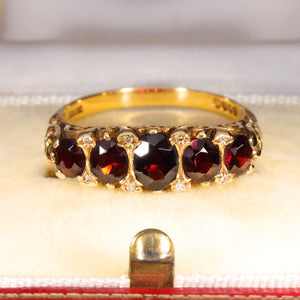Gemstones, Light, and Optics: A Glimpse into the Spectrum of Antique Jewellery
The radiant sparkle we admire in gemstones—particularly those set in antique rings —depends largely on how these stones interact with light. By reflecting, refracting, or absorbing specific wavelengths from the electromagnetic spectrum, gemstones reveal their signature hues and brilliance. In this post, we’ll explore the basics of gemstone optics, discuss their place within the electromagnetic spectrum, and show why these visual properties are so cherished in antique jewellery.
1. The Electromagnetic Spectrum and Gemstones
The electromagnetic (EM) spectrum encompasses all forms of light, ranging from radio waves to gamma rays. Visible light—what our eyes detect—occupies only a narrow band of this spectrum. Gemstones exhibit colour based on how they absorb or transmit different wavelengths of visible light:
- Absorption Patterns: Elements such as chromium, iron, and titanium within a gemstone can absorb certain wavelengths, bestowing each gem with its unique hue.
- Transmission: Wavelengths not absorbed pass through or reflect off the stone’s facets, reaching our eyes as colour.
2. Light Interactions in Gemstones
Beyond colour, gemstones rely on reflection, refraction, and dispersion to create the dazzling effects we often admire in antique jewellery.
- Reflection: Light bouncing off a gemstone’s polished surfaces and facets contributes to its shine.
- Refraction: As light enters the stone, it bends according to the gem’s refractive index, which can magnify its brilliance—especially in stones like diamond.
- Dispersion: Often referred to as “fire,” dispersion occurs when white light splits into spectral colours, lending stones like diamonds their vivid flashes under varying lighting conditions.
3. Optical Properties and Antique Jewellery
Antique jewellery frequently features gems cut by hand, using historic techniques that accentuate particular optical effects.
- Historic Cutting Styles: Old mine and old European cuts were designed to enhance candlelit sparkle, highlighting a gem’s natural brilliance in softer lighting.
- Rare Stones and Colours: Vintage pieces may host historical gemstones (e.g., demantoid garnet or alexandrite) that collectors prize for unusual colour shifts or striking dispersion.
3.1 Why Light Matters in Antique Gems
Antique gems can look warmer or demonstrate more “fire” under incandescent or natural light compared to modern cuts intended for brighter illumination. This interplay of angles and spectral reflection often amplifies the charm of older pieces.
4. Care Considerations for Light and Colour Retention
While gemstones typically retain their colour over time, certain environmental factors can still affect their optical qualities.
- Heat & Prolonged Sun Exposure: Some stones, such as amethyst, may fade if subjected to intense heat or strong UV light for extended periods.
- Cleaning Methods: Harsh chemicals or ultrasonic cleaners can dull or damage delicate antique settings or surface treatments.
5. Tips for Collectors and Enthusiasts
- Identify Stone Types: Familiarise yourself with basic gemology to appreciate each gem’s unique absorption traits and colour nuances.
- Evaluate Fire and Brilliance: Antique cuts may emphasise a gem’s colourful fire in ambient, lower-intensity lighting, making them stand out in vintage rings.
- Seek Expert Appraisals: Gems featuring exceptional optical phenomena—like star sapphires or strong colour-change effects—can hold significant value, particularly in antique pieces with provenance.
Conclusion
From colour absorption in the electromagnetic spectrum to the intricate dance of reflection and dispersion, gemstones owe much of their allure to their optical interactions with light. In antique jewellery, these properties are amplified by historical cutting styles and rare gem materials, granting each piece a timeless, enchanting quality. By understanding the fundamentals of gemstone optics, collectors and enthusiasts can more thoroughly appreciate why a well-chosen antique ring shimmers just as brilliantly today as it did generations ago.


